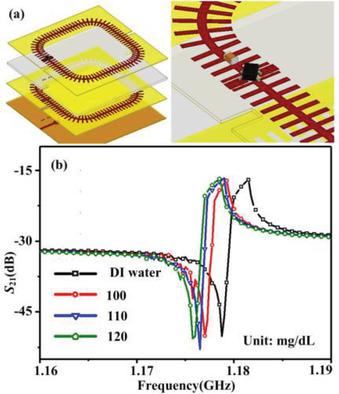当前位置:
X-MOL 学术
›
Adv. Mater. Technol.
›
论文详情
Our official English website, www.x-mol.net, welcomes your feedback! (Note: you will need to create a separate account there.)
Gain‐Assisted Active Spoof Plasmonic Fano Resonance for High‐Resolution Sensing of Glucose Aqueous Solutions
Advanced Materials Technologies ( IF 6.8 ) Pub Date : 2019-11-11 , DOI: 10.1002/admt.201900767 Yong Jin Zhou 1, 2 , Qiao Yu Li 1 , Hong Zhou Zhao 1 , Tie Jun Cui 3
Advanced Materials Technologies ( IF 6.8 ) Pub Date : 2019-11-11 , DOI: 10.1002/admt.201900767 Yong Jin Zhou 1, 2 , Qiao Yu Li 1 , Hong Zhou Zhao 1 , Tie Jun Cui 3
Affiliation

|
Fano resonance has received much attention in recent years due to its promising applications in surface enhanced phenomena, sensing, and nonlinear optics. However, it is challenging to achieve both high quality (Q) factor and high intensity using the Fano resonance. Different from active switching/tuning of plasmonic Fano resonances, gain‐assisted active spoof plasmonic Fano resonance is for the first time proposed to enhance both the Q factor and resonance intensity significantly, in which a subwavelength amplifier chip is incorporated into a passive plasmonic structure composed of two stacked corrugated metal rings. Experimental results show that the Q factor of the Fano resonance is increased from 49 to 2802, and the resonance intensity is improved from 19.89 to 37.42 dB. The high performance of the active plasmonic structure makes the limit of detection reach to 10 mg dL−1, and thus the minute change of glucose aqueous solutions has been successfully detected.
中文翻译:

增益辅助的主动欺骗等离子等离子体共振,可对葡萄糖水溶液进行高分辨率感测
近年来,由于其在表面增强现象,传感和非线性光学中的应用前景广阔,因此它受到了广泛的关注。但是,使用Fano共振实现高质量(Q)因子和高强度都具有挑战性。与等离子Fano共振的主动切换/调谐不同,首次提出了增益辅助的主动欺骗性等离子Fano共振,以显着增强Q因子和共振强度,其中将亚波长放大器芯片整合到了由无源等离激元构成的结构中两个堆叠的波纹金属环。实验结果表明,QFano共振的系数从49增加到2802,共振强度从19.89 dB改善到37.42 dB。活性等离激元结构的高性能使检测极限达到10 mg dL -1,因此已成功检测出葡萄糖水溶液的微小变化。
更新日期:2020-01-13
中文翻译:

增益辅助的主动欺骗等离子等离子体共振,可对葡萄糖水溶液进行高分辨率感测
近年来,由于其在表面增强现象,传感和非线性光学中的应用前景广阔,因此它受到了广泛的关注。但是,使用Fano共振实现高质量(Q)因子和高强度都具有挑战性。与等离子Fano共振的主动切换/调谐不同,首次提出了增益辅助的主动欺骗性等离子Fano共振,以显着增强Q因子和共振强度,其中将亚波长放大器芯片整合到了由无源等离激元构成的结构中两个堆叠的波纹金属环。实验结果表明,QFano共振的系数从49增加到2802,共振强度从19.89 dB改善到37.42 dB。活性等离激元结构的高性能使检测极限达到10 mg dL -1,因此已成功检测出葡萄糖水溶液的微小变化。



























 京公网安备 11010802027423号
京公网安备 11010802027423号